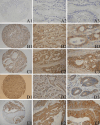OLFM4 is associated with lymph node metastasis and poor prognosis in patients with gastric cancer
- PMID: 21904905
- PMCID: PMC11828170
- DOI: 10.1007/s00432-011-1042-9
OLFM4 is associated with lymph node metastasis and poor prognosis in patients with gastric cancer
Abstract
Purpose: The present study investigated the clinical significance of the relationship between olfactomedin 4 (OLFM4) expression and the clinicopathological features of patients with gastric cancer.
Methods: Tumor tissue and adjacent normal tissue, lymph nodes, and peritoneal metastases were analyzed by the Affymetrix GeneChip(®) HG-U133A2.0 array. The expression of OLFM4 was detected by real-time quantitative RT-PCR in gastric tumor tissue and adjacent normal tissue. OLFM4 expression was analyzed by immunohistochemistry in 436 clinicopathologically characterized gastric cancer cases and in corresponding distant metastases from 61 patients.
Results: A total of 434 genes and 169 expressed sequence tags were upregulated, including OLFM4. The expression of OLFM4 mRNA or protein differed significantly among gastric tumor tissue, matched normal gastric mucosa, and lymph node metastases. Further multivariate analysis suggested that lymph node metastases and distant metastases, TNM stage, and expression of OLFM4 were independent prognostic indicators for gastric cancer.
Conclusion: Gene expression profiles were useful for simultaneously analyzing the expression levels of thousands of genes. Reduced expression of OLFM4 in gastric cancer is associated significantly with lymph node and distant metastases and with poor prognosis. OLFM4 may prove to be an important molecular marker for predicting the carcinogenesis, development, progression, and metastasis of gastric cancer.
Conflict of interest statement
We declare that we have no conflict of interest.
Figures





Similar articles
-
High-level expression of S100A4 correlates with lymph node metastasis and poor prognosis in patients with gastric cancer.Ann Surg Oncol. 2010 Jan;17(1):89-97. doi: 10.1245/s10434-009-0722-z. Epub 2009 Oct 10. Ann Surg Oncol. 2010. PMID: 19820999
-
Identification of proteins associated with lymph node metastasis of gastric cancer.J Cancer Res Clin Oncol. 2014 Oct;140(10):1739-49. doi: 10.1007/s00432-014-1679-2. Epub 2014 May 15. J Cancer Res Clin Oncol. 2014. PMID: 24828259 Free PMC article.
-
AEG -1 overexpression: a novel indicator for peritoneal dissemination and lymph node metastasis in epithelial ovarian cancers.Int J Gynecol Cancer. 2011 May;21(4):602-8. doi: 10.1097/IGC.0b013e3182145561. Int J Gynecol Cancer. 2011. PMID: 21543927
-
Diagnostic accuracy of endoscopic ultrasonography (EUS) for the preoperative locoregional staging of primary gastric cancer.Cochrane Database Syst Rev. 2015 Feb 6;2015(2):CD009944. doi: 10.1002/14651858.CD009944.pub2. Cochrane Database Syst Rev. 2015. PMID: 25914908 Free PMC article.
-
CD133 overexpression correlates with clinicopathological features of gastric cancer patients and its impact on survival: a systematic review and meta-analysis.Oncotarget. 2015 Dec 8;6(39):42019-27. doi: 10.18632/oncotarget.5714. Oncotarget. 2015. PMID: 26503471 Free PMC article.
Cited by
-
Olfactomedin-4 in digestive diseases: A mini-review.World J Gastroenterol. 2018 May 7;24(17):1881-1887. doi: 10.3748/wjg.v24.i17.1881. World J Gastroenterol. 2018. PMID: 29740203 Free PMC article. Review.
-
Epstein-Barr virus infection upregulates extracellular OLFM4 to activate YAP signaling during gastric cancer progression.Nat Commun. 2024 Dec 4;15(1):10543. doi: 10.1038/s41467-024-54850-6. Nat Commun. 2024. PMID: 39627192 Free PMC article.
-
Characterization of differentially expressed genes involved in pathways associated with gastric cancer.PLoS One. 2015 Apr 30;10(4):e0125013. doi: 10.1371/journal.pone.0125013. eCollection 2015. PLoS One. 2015. PMID: 25928635 Free PMC article.
-
High expression of olfactomedin-4 is correlated with chemoresistance and poor prognosis in pancreatic cancer.PLoS One. 2020 Jan 10;15(1):e0226707. doi: 10.1371/journal.pone.0226707. eCollection 2020. PLoS One. 2020. PMID: 31923206 Free PMC article.
-
Oestrogen receptor-mediated expression of Olfactomedin 4 regulates the progression of endometrial adenocarcinoma.J Cell Mol Med. 2014 May;18(5):863-74. doi: 10.1111/jcmm.12232. Epub 2014 Feb 4. J Cell Mol Med. 2014. PMID: 24495253 Free PMC article.
References
-
- Aung PP, Oue N, Mitani Y et al (2006) Systematic search for gastric cancer-specific genes based on SAGE data: melanoma inhibitory activity and matrix metalloproteinase-10 are novel prognostic factors in patients with gastric cancer. Oncogene 25(17):2546–2557 - PubMed
-
- Chin KL, Aerbajinai W, Zhu J et al (2008) The regulation of OLFM4 expression in myeloid precursor cells relies on NF-kappaB transcription factor. Br J Haematol 143(3):421–432 - PubMed
-
- Grutzmann R, Pilarsky C, Staub E et al (2003) Systematic isolation of genes differentially expressed in normal and cancerous tissue of the pancreas. Pancreatology 3(2):169–178 - PubMed
-
- Huang Y, Yang M, Yang H et al (2010) Upregulation of the GRIM-19 gene suppresses invasion and metastasis of human gastric cancer SGC-7901 cell line. Exp Cell Res 316(13):2061–2070 - PubMed
Publication types
MeSH terms
Substances
LinkOut - more resources
Full Text Sources
Medical
Miscellaneous

